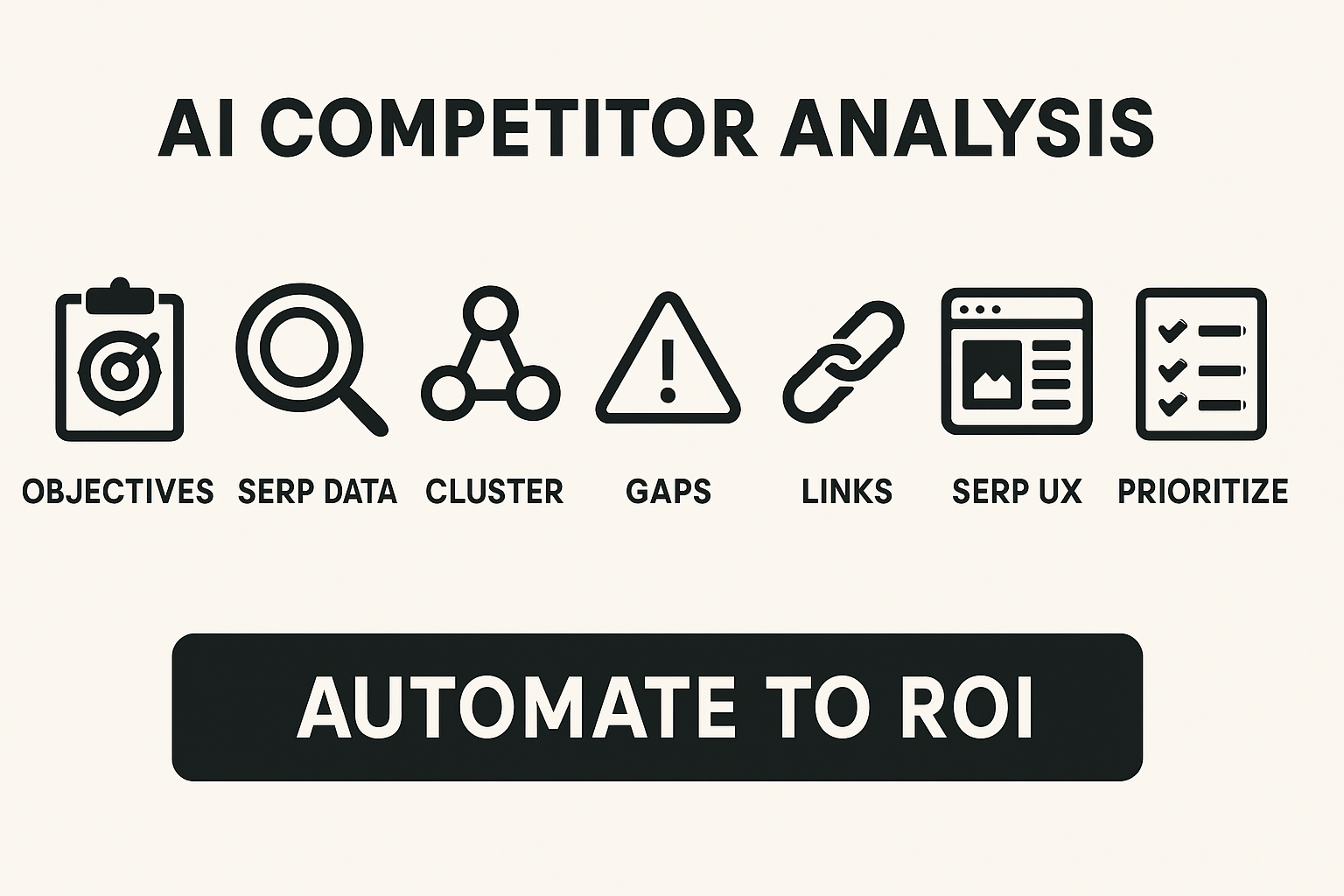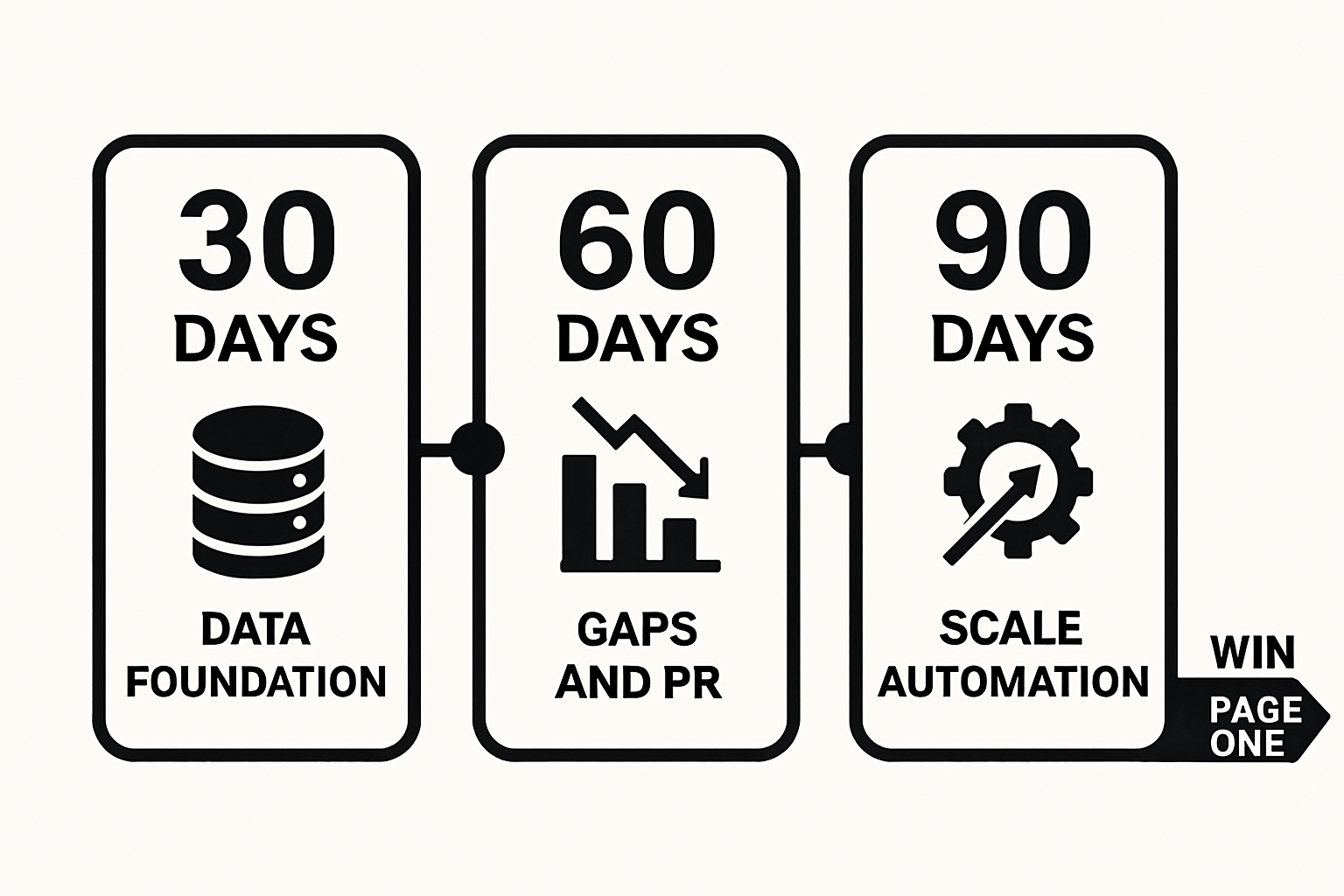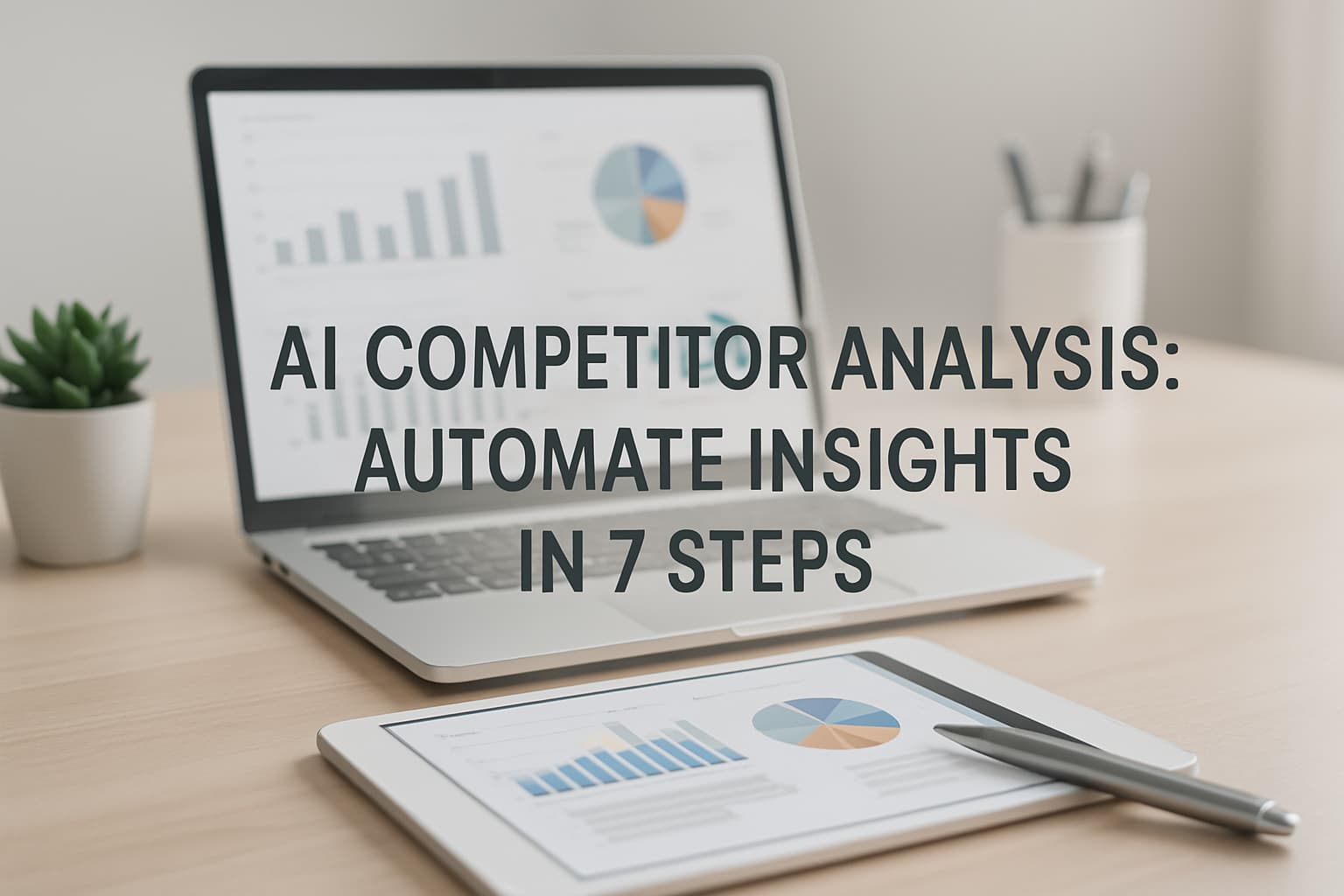Your competitors are moving faster than ever. With AI competitor analysis, you can turn scattered signals into an automated system that surfaces what to write next, where to earn links, and how to outrank page-one leaders—without drowning in manual work.
In this guide, you’ll learn a proven 7-step framework, the data to track, free vs paid tool paths, KPIs that matter, a 30/60/90-day rollout, advanced AI prompts, a practical case example, and when to automate it all with SEOsolved.
What Is AI Competitor Analysis and Why It Matters Now
AI competitor analysis is the automated collection, enrichment, and interpretation of competitor and SERP data using machine learning, LLMs, and rules-based scoring to drive marketing decisions that grow traffic, leads, and revenue.
Instead of manual snapshots, AI builds a living system: it pulls SERP and site data, clusters keywords by intent, highlights content gaps and authority deficits, and translates findings into prioritized actions. Industry sources note that starting with clear objectives—not random data—turns intel into strategy and speed (see Miro’s framework), while modern AI agents automate end-to-end research so teams make faster, smarter decisions.
- Commercial impact: Better rank share and demand coverage → more qualified traffic → more pipeline and revenue proxies.
- Scope & accuracy: Automate repetitive, rules-heavy tasks (data gathering, clustering, comparisons). Keep human QA for briefs, facts, and compliance.
- US SERPs nuance: Normalize by US locale, device type, and feature mix (snippets, PAA, local) to reflect your buyers’ reality.

The 7-Step Automation Framework (From Data to Decisions)
Automate this end-to-end workflow so weekly decision-making becomes systematic and ROI-driven.
- Define objectives, ICP, and competitor set.
- Collect SERP and site data programmatically.
- Discover and cluster keywords with AI.
- Run content gap and entity analysis.
- Benchmark links, authority, and digital PR.
- Model SERP features and UX signals.
- Prioritize actions and automate reporting.
Each step produces inputs for the next, shortening time-to-value and linking work to KPIs like rank share and demand coverage.
Step 1 — Define Objectives, ICP, and Competitor Set
Start with decisions, not data dumps. Define what success looks like for the next quarter:
- Metrics: Traffic share (estimated traffic captured), rank share (positions weighted across your keyword universe), a revenue proxy (e.g., qualified sessions × conversion rate × AOV/LTV).
- ICP (Ideal Customer Profile): Industry, company size, geo (US), buyer role, problems.
Build a relevant competitor list algorithmically:
- SERP overlap: Sites ranking for 30%+ of your priority clusters.
- Co-ranking score: Weighted by positions (1–3 > 4–10 > 11+).
- Intent fit: Exclude forums if you sell B2B, or non-US sites if you sell in the US.
- Brand queries: Include rivals that capture your brand + category terms.
Step 2 — Programmatically Collect SERP & Site Data
Automate data ingestion so it’s repeatable and compliant:
- SERP APIs: Pull top results, features (snippets, PAA, local packs), titles, and URLs by US locale and device. Respect API terms and robots directives.
- Site crawls: Extract headings, schema, internal links, canonicalization, meta data, and fetch/render timing.
- Public sources: Use syndication, newsroom, and PR pages for authority signals.
- Normalization: Store with fields for keyword, cluster, device, locale, date, position, and feature presence.
- Warehouse: BigQuery/Postgres + object storage for HTML snapshots.
Step 3 — Discover and Cluster Keywords with AI
Group keywords by search intent and funnel stage using embeddings and LLMs:
- Generate vector embeddings for each keyword and title tag.
- Cluster via cosine similarity; label clusters with an LLM summary.
- Assign funnel stage (problem, solution, product, transactional).
- Score opportunities: demand (volume), difficulty (SERP strength), business fit (ICP match), and feature opportunity (e.g., snippet eligibility).
Output: a prioritized cluster backlog with target pages and SERP features to pursue.
Step 4 — Run Content Gap & Entity Analysis
Compare your coverage to competitors for each cluster:
- Topical gaps: Missing subtopics and questions competitors cover.
- Entity SEO: Extract required entities and relationships that top pages include.
- E-E-A-T cues: Author expertise, citations, and first-party experience evidence.
- Roadmap: Turn gaps into briefs with required headings, entities, and references.
Step 5 — Benchmark Links, Authority, and Digital PR
Authority wins tough SERPs. Benchmark by cluster:
- Referring domains: Unique, relevant domains by topic.
- Link velocity: Monthly net gains; identify spikes from PR or features.
- Anchor distribution: Branded vs. partial/exact match; avoid over-optimization.
- PR angles: Data studies, expert commentary, and partnerships to fill gaps.
Step 6 — Model SERP Features and UX Signals
Track what correlates with rankings in your niche:
- Features: People Also Ask, featured snippets, image/video packs, local packs.
- Core Web Vitals: LCP, INP, CLS by template; prioritize templates that underperform.
- On-page UX patterns: Readability, structure, jump links, FAQs, and schema presence.
Look for patterns, not absolutes; correlation isn’t causation, but it guides experiments.
Step 7 — Prioritize Actions and Automate Reporting
Convert insights into a sprint-ready backlog:
- Scoring: RICE (Reach, Impact, Confidence, Effort) or ICE; include forecasted rank-lift and traffic delta.
- Scorecards: Weekly dashboards for rank share, content velocity, and authority growth by cluster.
- Alerts: Slack/email when competitors ship new content, win snippets, or gain significant links.
Data You Need: The Competitive Signal Checklist
Focus automation on the highest-signal inputs, with a monitoring cadence that matches your market speed.
Keywords & SERP Landscape
- Scope: Head, mid, long-tail across US SERPs; track 500–5,000 terms depending on market breadth.
- Share of voice: % of top-10 results your brand occupies per cluster.
- Cannibalization: Detect multiple URLs ranking for the same term and consolidate.
- Feature tracking: Snippets, PAA, local packs; flag clusters where features dominate clicks.
Content Depth, Structure, and Entities
- Headers and outline: H2/H3 coverage of required subtopics.
- Semantic entities: People, places, products, and concepts extracted from top results.
- Reading level: Match audience; avoid walls of text.
- Freshness: Publication/update recency versus competitors.
Backlinks & Authority Metrics
- Referring domains: Topic-relevant domains per cluster.
- Velocity: Month-over-month gains and losses.
- Topical authority: Interlinking across related clusters and hub content.
Technical Health & Experience Signals
- Core Web Vitals: Template-level LCP/INP/CLS.
- Indexation & canonicals: Coverage and duplication control.
- Schema markup: Article, FAQ, Product, LocalBusiness—aligned to content type.
- Internal links: Contextual links to raise page-level authority.
Tooling: Free vs Paid Paths to AI Competitor Analysis
Choose a stack that fits your budget, scale, and time-to-value. Free paths validate; platforms win on speed, depth, and governance.
Build a Free/Low-Cost Stack
- Data: Google Search Console/GA4 exports; limited free SERP API credits.
- Processing: Python notebooks, embeddings via open models, lightweight Postgres/SQLite.
- Automation: Cron or GitHub Actions; low-code tools like Make/Zapier on free tiers.
- Monitoring: Track competitor page changes with Visualping’s alerts to stay proactive.
- Dashboards: Google Sheets/Looker Studio for rank share and coverage views.
Great for ai competitor analysis free on small datasets. Expect manual QA and slower iteration at scale.
When to Upgrade: Scale, Quality, and Time-to-Value
- Tracking thousands of keywords across many clusters and competitors.
- Publishing 10+ articles/month with strict editorial guardrails.
- Weekly executive reporting and alerting requirements.
- Need for forecast-driven prioritization and E-E-A-T enforcement.
Where SEOsolved Fits: End-to-End Automation
SEOsolved automates competitor analysis, keyword discovery, roadmap creation, and monthly content production. You provide your URL; the platform analyzes competitors, uncovers 500+ keywords, and produces 30–60 in-depth, SEO-optimized, credibly sourced articles every month in ~10 minutes of your time per week.
- Problems solved: No-time strategy, thin or ad-hoc content, slow production, and inconsistent QA.
- Built-in governance: Brand and editorial guardrails, source attribution, and entity coverage.
- Time savings: Reclaim 80+ hours/month by moving from manual to managed.
Stat Ranking Today and turn analysis into compounding traffic and authority.
KPIs, Benchmarks, and Dashboards That Drive Action
Design KPIs that tie directly to decision-making and weekly prioritization.
Traffic Share, Rank Share, and Coverage
Quick definitions for fast alignment:
- Traffic share: Estimated traffic captured across your universe versus competitors.
- Rank share: Position-weighted share of top 10 results, by cluster and funnel stage.
- Coverage: % of opportunity clusters with at least one page targeting them.
Compute per cluster and roll up to executive views. Use alerts for sudden drops or competitor surges.
Content Velocity, Quality, and Freshness
- Velocity: Pages shipped per week by cluster.
- Depth score: Entity coverage, outline completeness, and reading ease.
- Freshness: Median days since last update versus top competitors.
Consider republishing to re-capture snippets and PAA real estate.
Authority Growth and PR Momentum
- Referring domain growth: Net new domains/month per cluster.
- Authority movement: Category-level authority and internal link lift.
- PR outcomes: Earned placements, quotes, and digital mentions.
30/60/90-Day Implementation Roadmap
Deploy automation fast, prove value, then scale. Here’s a practical plan.
Days 0–30: Data Foundation and Quick Wins
- Define objectives, ICP, and competitor set.
- Stand up SERP/site pipelines; normalize by US device/locale.
- Cluster keywords; pick 3–5 low-difficulty clusters.
- Ship first briefs and articles; add FAQ and snippet-targeted blocks.
- Implement dashboards and basic alerts.
Days 31–60: Gap Closing and Authority Moves
- Execute content gap roadmap across 10–20 pages.
- Launch digital PR for 2–3 priority clusters.
- Refine internal linking and schema coverage.
- Optimize Core Web Vitals for slow templates.
Days 61–90: Scale, Automate, and Systematize
- Increase publishing cadence; templatize briefs and outlines.
- Automate weekly reporting and anomaly alerts.
- Institutionalize backlog grooming and sprint rituals.
- Expand keyword universe and cluster coverage.

Advanced AI Recipes, Prompts, and Automations
Use these prompt patterns and automations to accelerate analysis while maintaining QA.
Prompts for SERP Pattern and Entity Extraction
Copy, adapt, and run with your own SERP snapshots.
Prompt: “You are an SEO analyst. Given top-10 US results for [cluster], summarize common patterns (headings, entities, content length, schema, CWV cues). Output: required entities, must-cover subtopics, snippet/PAA opportunities, and risks. Return a checklist.”
Brief Generation and Outline Validation
Prompt: “Create a content brief for [target keyword] targeting [ICP] in the US. Include H2/H3 outline, required entities, reading level, internal links, and 3 credible external sources. Enforce E-E-A-T with author role and first-hand evidence sections.”
Before publishing, review meta elements. For help crafting high-CTR snippets, see our Meta Description Generator.
Zapier/Make Pipelines and Alerting
- Trigger on new competitor URLs in top 10 → scrape outline/entities → auto-brief → task in your PM.
- Web change alerts for competitor pages → Slack notification with diffs.
- Weekly job → refresh rank share, coverage, and link velocity → email dashboard.
Case Example: From Invisible to Page 1 Using Automation
The following is a hypothetical but realistic scenario of a US startup applying this framework over 90 days.
Baseline: Low Visibility and Fragmented Effort
- 20 blog posts, no clustering, inconsistent on-page structure.
- No rank share tracking; minimal PR and weak internal links.
- Manual research consuming the team’s time.
Actions Taken: Automated Insights to Execution
- Automated SERP tracking and keyword clustering across 1,200 terms.
- Gaps converted into briefs targeting 15 high-fit clusters.
- Launched two data-driven PR angles; improved internal linking to hubs.
- Modeled snippets and PAA; added FAQs and schema to contenders.
Outcomes: Traffic, Leads, and Authority
- Meaningful lift in rank share across priority clusters.
- Higher coverage of addressable demand and improved CTR from richer snippets.
- Steady growth in referring domains and authority momentum.
Directionally, these wins compound when delivery is consistent and guided by automated insights rather than ad-hoc efforts.
Common Pitfalls (and How to Avoid Them)
Choosing the Wrong Competitors
Use SERP overlap and intent fit to avoid model drift. Exclude non-overlapping forums or non-US sites if your market is the US.
Over-Reliance on Averages and Thin Data
Use robust sampling, confidence thresholds, and seasonality controls. Re-run analyses monthly to catch shifts.
Automating Without Editorial QA
Insert human checkpoints for brief acceptance, factual review, and compliance. Automate gathering; human-review meaning.
Compliance, Ethics, and Sustainability
Data Privacy and Terms of Service
Respect robots.txt, API terms, and PII standards. Prefer APIs and lawful public sources; store only what you need and audit access.
Attribution and Credible Sourcing
Maintain traceability for claims and statistics. Cite credible sources and keep links up to date to reinforce trust and E-E-A-T.
Automate It All with SEOsolved
How SEOsolved Works (10 Minutes a Week)
- Input your URL and ICP details.
- AI analyzes competitors and discovers 500+ keywords.
- Platform builds a prioritized content roadmap.
- SEOsolved produces 30–60 in-depth, optimized, credibly sourced articles monthly.
- You review highlights and publish—about 10 minutes per week.
Why It Beats DIY and “Free” Stacks
- Total cost of ownership: Eliminate tool sprawl and custom maintenance.
- Scale and accuracy: Enterprise-grade clustering, gap analysis, and QA.
- Time savings: Reclaim 80+ hours per month—focus on strategy, not wrangling data.
CTA: Start Earning Rankings and Revenue
Ready to compound visibility with less effort? Stat Ranking Today.
FAQ: Your Top Questions Answered
Can I do ai competitor analysis free?
Yes—use GSC/GA4, limited SERP API credits, open embeddings, and Sheets dashboards. It’s ideal for small datasets but gets manual at scale; upgrade when volume and cadence increase.
How fast can I see results?
Expect directional wins in 30–60 days from low-hanging clusters; more competitive terms and authority moves typically materialize in 60–90 days+ with consistent publishing.
Will AI-generated content hurt rankings?
Quality wins. Enforce originality, entity coverage, credible citations, and human QA. Platforms like SEOsolved embed guardrails for E-E-A-T and source attribution.
What KPIs should I track weekly?
Rank share, demand coverage, content velocity, snippet/PAA capture, and referring domain growth; review per cluster and roll up to executive views.
How do I capture snippets without keyword stuffing?
Answer directly in 40–60 words, include entities, use clear headings, add FAQ schema, and keep reading level aligned to your audience.
